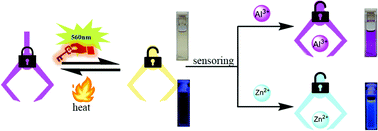A visible-light-gated donor–acceptor Stenhouse adduct chemosensor: synthesis, photochromism and naked-eye colorimetric/fluorometric sensing of Al3+ and Zn2+†
Abstract
In this study, a new visible-light-gated donor–acceptor Stenhouse adduct (DASA) chemosenor with a Schiff base naphthalene unit was successfully designed and synthesized. The synthesized ND-O exhibited typical and excellent negative photochromic properties in a solution. It also possessed multi-responsive photoswitchable properties under visible light, heat, and in the presence of metal ions. After activation by visible light, the purple ND-O was converted to the nearly colorless ND-C (ring-closed form). Remarkably, this ND-C could not only be utilized as a colorimetric chemosensor to recognize Al3+ by evident color changes in solution but also could be used as a fluorescence chemosensor to detect Zn2+ by a noticeable enhancement of the emission intensity and change in fluorescence color. The lowest detection limits for Al3+ and Zn2+ ions were 3.65 × 10−7 mol L−1 and 1.00 × 10−7 mol L−1, respectively. The binding mode of ND-C with Al3+ and Zn2+ was determined as a 1 : 1 coordination stoichiometry by employing fluorescence titration curves and Job's plot analysis.



 Please wait while we load your content...
Please wait while we load your content...